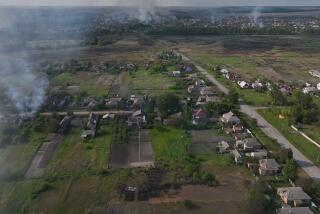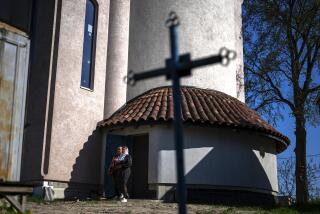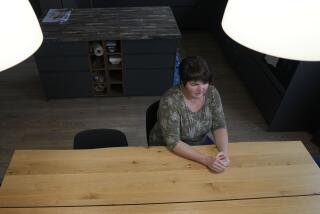Town Torn Asunder Faces New Pain : Croatia: Wartime shift in population left Vukovar a city of Serbs. But Zagreb vows to reclaim it.
VUKOVAR, Croatia — Zivko Popovich is a square-faced, gritty little man whose life capsized in the waves of ethnic hate that first began destroying the Yugoslav federation in the summer of 1991.
By the time he found his bearings, Popovich and his family had landed in the ruins of this once-rich Danube River port town. Along with thousands of other refugees, they began again.
Their ordeal was part of a violent shift of populations that saw about half a million Croats and Serbs flee to the safety of their own kind amid the horrors of ethnic slaughter.
The result left Vukovar effectively a town of Serbs, protected by Serbian military forces, yet inside the internationally recognized borders of Croatia.
Four winters later, Vukovar is slowly lifting itself out of the ruins. It is a town in which only a handful of Croats remain and two-thirds of the 30,000 residents are men and women like the Popovich family members, driven from their original homes by Croats.
“We live here now,” Popovich said. “We have no other home.”
For those nations, including the United States, trying to broker a diplomatic settlement in the Balkans, the new ethnic makeup of Vukovar and scores of communities like it in Serb-occupied Croatia constitute one of the toughest obstacles to a lasting peace: how to square the commitment to restore Croatia’s legally recognized frontiers with the changed ethnic realities.
Thanks to a decision by Croatian President Franjo Tudjman to expel U.N. peacekeepers monitoring a 1,000-mile-long cease-fire line that has kept Croats and Serbs from killing each other during much of the last year, the search for peace has also become a race against the clock.
The expulsion--technically a Croatian refusal to renew the United Nations’ mandate--becomes effective March 31, although authorities in Zagreb, the capital, have indicated that they will allow the 12,000 peacekeepers as many as three months to complete their withdrawal.
If there is no peace by then, the risk of a new war--with a new wave of refugees--will rise sharply.
Under the terms of the latest plan, the United States, Britain, France, Germany and Russia are trying to coax Serbian President Slobodan Milosevic to formally recognize Croatia and Bosnia-Herzegovina by dangling the prospect of an end to international sanctions against his country.
If Milosevic agrees--and there are signs he is seriously considering such a move--he would, in effect, be acknowledging Croatia’s ultimate sovereignty over population centers such as Vukovar.
But many Serbs insist that it is precisely this move that would bring a new explosion of ethnic violence.
Few communities better illustrate this diplomatic dilemma than Vukovar, once a model of ethnic harmony and the Yugoslav federation’s prosperity.
Before Vukovar’s destruction in 1991, its population of about 40,000 was a near-even mix of Serbs and Croats, along with a smattering of Hungarians and other minorities drawn by the opportunities of the area’s rich soil, good wines, attractive river beaches and abundant natural resources that even include some oil.
What nature did not provide, the people of Vukovar added--including factories that produced shoes, tires, textiles and blankets that were exported to the United States.
The town boasted the Yugoslav federation’s second-largest river port, and more cars and telephones per capita than any town outside Belgrade.
“Life was good here,” said Slobodan Popovic, a local government official. “Our living standard was very high.”
It was this Vukovar that became part of an independent Croatia in the summer of 1991.
But in the late summer and autumn of that year, the nightmare began.
Vukovar became an ethnic battleground where Serbian and Croatian neighbors turned on each other, and the predominantly Serbian Yugoslav National Army, deployed to protect the town’s Serbian population, fought an outgunned Croatian militia trying to hold the town.
By the time the last Croatian resistance ended in mid-November, there was little left of Vukovar. Local officials claim that 2.5 million rounds of ammunition fell on the town during those months, destroying 95% of its buildings. Haunting ruins still dominate the landscape.
The majority of Vukovar’s residents fled the fighting, and in the immediate aftermath those Croats among the survivors were either expelled or executed. At the end of the carnage, about 2,500 people remained.
Since then, the town has gradually revived.
The large Borovo shoe factory is back in operation, as is the textile plant. Sixty miles of roads have been rebuilt; essential services such as electricity, water and telephone have been restored; six of the town’s eight schools have reopened, and clearance of the vast stretches of bombed and burned-out buildings is scheduled to start this summer.
*
The work is painfully slow. Vukovar’s status as part of Serb-occupied Croatia (a region the Serbs call the Republic of Serbian Krajina) means that there is no international help for reconstruction. The impact of U.N.-imposed economic sanctions on Serbia also limits any assistance from Belgrade.
“We’re rebuilding on our own,” said Dusan Teofilovic, head of Vukovar’s local government. “We have no help.”
At the local high school, the isolation is especially visible. Geography teacher Vojin Krstic said he has no maps to teach with and no money for other teaching aids, and his students have neither the opportunity nor the money for travel.
The pupils’ one link with the outside world is through groups of students from a Dutch high school who occasionally visit.
But there is progress. Despite the hardships, Krstic said student morale has bounced back.
“When we first reopened after the war, there was only silence,” he said. “The worst thing for a teacher is when there is no laughter among his students. Now I hear it again.”
But as Vukovar revives itself, it does so with different people.
The Popoviches, for example, were driven from their home 20 miles northwest in Osejik by a dominant and hostile Croatian population.
“Friends I’d had all my life, friends from school, suddenly were accusing me of receiving special treatment because I was Serb,” Zivko Popovich recalled. “We all knew it wasn’t true, but that didn’t seem to matter.”
*
After a long struggle, he has a roof over his head and schooling for his children, and he even earns a living of sorts trading goods at the town’s market. Still, he said he would move again if Croatian sovereignty returned to Vukovar.
“I wouldn’t stay,” he said. “I’d go to Serbia.”
Those native to Vukovar, with a deeper commitment to the land and community, have another response to such a prospect: to fight.
“There aren’t many here (who) would accept Croatian control,” Teofilovic said grimly. “There would be another war.”
Unlike much of the rest of the 5,400 square miles of Serb-occupied Croatia, Vukovar and its surroundings are very near to Serbia itself, a fact that would make it far more difficult for Croats to retake the city by force should hostilities break out again.
In the search for peace, diplomats have already presented at least two compromise plans based on the return of occupied land to Croatia, but with varying degrees of local autonomy. In both instances, however, the ideas were summarily rejected by rebel Serb authorities.
With time running out on the U.N. peacekeeping mission in the region, a new uncertainty hangs over the town.
“I had a chance to go somewhere else, to go to Belgrade and lead an easier life, but I love this place,” Teofilovic said. “Vukovar has a good future.”
Then, after a pause, he added quietly, “But I see turmoil ahead.”
Marshall was recently on assignment in Vukovar.
More to Read
Sign up for Essential California
The most important California stories and recommendations in your inbox every morning.
You may occasionally receive promotional content from the Los Angeles Times.










